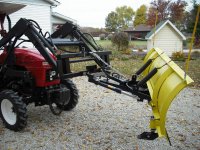I'm in southeast VA, where we were just smacked with the biggest snowfall in over two decades. Last year we had significantly more snow than normal, and this year we had four snowfalls before the first day of winter (five so far).
Once last year, and for this past 12"+ snowfall, I hooked the rear blade to the tractor and worked on clearing the 500ft private driveway (~350ft is paved). Some of the time everything lined up just right, and snow would discharge from the end of the blade, but most of the time the snow just piled up between the blade and the tractor, dragging a big pile down the driveway (making things worse). It's an old 6ft blade. The only adjustment I can see (on the blade itself) is to change the angle (parallel to the rear axle, or 4 other settings, 2 in each direction). There's also the 3ph settings. How do you setup a rear blade for snow removal? Should I remove the rust, paint and/or wax the blade to help the snow slide across it?
Also, what's the thought on removing ice on public roads? About 100 ft from the top of our driveway is a very sharp curve (90 degree bend), which, from looking at the tracks in the snow, at least four vehicles have slid through in the past two days. About five years ago, someone slid through the curve and knocked down the utility pole, resulting in no electricity for this area on a very cold night. Right now, the curve is 2" of ice and in the shade. The local govt hasn't touched this road with anything (snow plow/salt/sand/etc), and the snow stopped two days ago. I don't see a rear blade doing any good here. Is there something I can put down (other than a bonfire) to help keep people from sliding through the curve?
Thanks
Keith
Once last year, and for this past 12"+ snowfall, I hooked the rear blade to the tractor and worked on clearing the 500ft private driveway (~350ft is paved). Some of the time everything lined up just right, and snow would discharge from the end of the blade, but most of the time the snow just piled up between the blade and the tractor, dragging a big pile down the driveway (making things worse). It's an old 6ft blade. The only adjustment I can see (on the blade itself) is to change the angle (parallel to the rear axle, or 4 other settings, 2 in each direction). There's also the 3ph settings. How do you setup a rear blade for snow removal? Should I remove the rust, paint and/or wax the blade to help the snow slide across it?
Also, what's the thought on removing ice on public roads? About 100 ft from the top of our driveway is a very sharp curve (90 degree bend), which, from looking at the tracks in the snow, at least four vehicles have slid through in the past two days. About five years ago, someone slid through the curve and knocked down the utility pole, resulting in no electricity for this area on a very cold night. Right now, the curve is 2" of ice and in the shade. The local govt hasn't touched this road with anything (snow plow/salt/sand/etc), and the snow stopped two days ago. I don't see a rear blade doing any good here. Is there something I can put down (other than a bonfire) to help keep people from sliding through the curve?
Thanks
Keith






